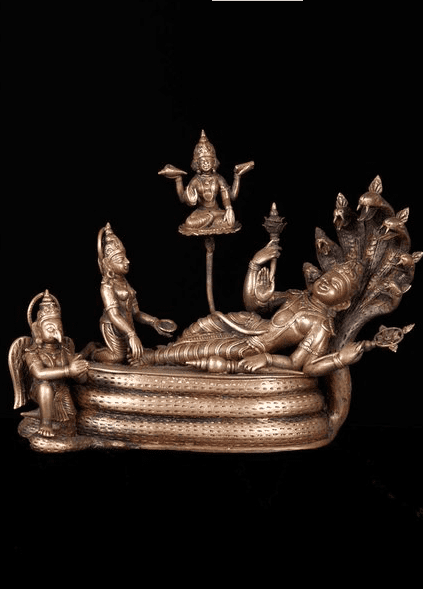Tonse N. K. Raju
Gaithersburg, Maryland, United States
It is a simple dimple in the mid-abdomen. Yet for medieval artists, it caused mighty headaches while painting portraits of Adam and Eve. Painting the dimple as a natural anatomic feature could be construed as sacrilegious, implying that Adam and Eve were connected by umbilical cords to their respective mothers during intrauterine life. But not showing them could also be blasphemous for depicting God’s creations as imperfect or incomplete. So the problem was more than skin deep. Although most artists dared to paint the umbilicus, some famous artists decided not to (Figure 1).
The Hindus’ sacred books tell the legend that Lord Brahma (Figure 2), the creator of the universe, was himself “born” atop of a lotus flower, its stem rooted in the navel of Vishnu, the God of Protection. The symbolism implied that all life forms are interconnected through umbilical cords, attached to their past in an eternal cycle.
In Omphalos’ Greek mythology, Zeus wanted to know the center of the earth’s location and released two eagles from opposite ends of the earth’s perimeter, ordering them to fly at equal speeds toward each other until they met. They met at Delphi, which thus was designated the “center of the earth.” The Omphalos Stone (Figure 3) adorned the spot where previously there was the Temple of Apollo. It was inscribed on many Greek coins and ancient art objects, showing a marble stone-shaped half-egg guarded by one golden eagle on either side. “Omphalos” became synonymous with “the center,” and the belly button symbolized the location of the origin of life.
Back to the artists’ dilemma. In painting portraits of Adam and Eve, some artists used innovative approaches to conceal the umbilical region, including Adam and Eve holding twigs and leaves in their hands with their arms artfully crossing the abdomen, obscuring the troublesome dimple.
In 1969 a south Indian scholar writing in the Kannada language famously titled his first collection of poems No Lotus in the Navel,1 mischievously implying that as a spontaneously-born poet he had no lineage and thus was peerless. The collection was critically acclaimed.
Things indeed have changed.
 |
 |
 |
| Adam and Eve in Paradise (tempera on panel), Scorel, Jan van (1495-1562) License and courtesy: Johnny van Haeften Gallery, London, UK. Bridgeman Images. | Lord Brahma on the lotus connected to Lord Vishnu through the lotus stem attached at the umbilicus. Courtesy, Mr. Kyle Tortora. www.lotussculpture.com. Bronze; total height including the base, 9″; Base width & depth, 15″X 6″; weight 18 pounds. | Omphalos stone, Delphi. Thought to be a (Roman?) replica of the original sacred stone which mysteriously disappeared and was displayed outside the temple. Photo by Юкатан 2009. Via Wikimedia |
References:
- A. K. Ramanujan. No Lotus in the Navel in, Raju T.N.K. and Daniels-Ramanujan, M. (Translators); Poems and a Novella by A. K. Ramanujan, Oxford University Press, New Delhi, 2006. Pages 3-58.
TONSE N. K. RAJU, MD (Pediatrics), DCH, FAAP, completed pediatric residency at Cook County Hospital and Neonatal-Perinatal Medicine fellowship at the University of Illinois in Chicago, where he served as Professor of Pediatrics. In 2002, he joined the National Institutes of Health in Bethesda, Maryland, as a Medical Officer where he became the Chief of Pregnancy and Perinatology Branch in 2013. He is currently an Adjunct Professor of Pediatrics at the Uniformed Services University in Bethesda and the Deputy Editor for the Journal of Perinatology, the official journal of the Section on Neonatal Perinatal Medicine of the American Academy of Pediatrics.
Highlighted Vignette Volume 13, Issue 2– Spring 2021
Winter 2021 | Sections | Art Flashes

Leave a Reply